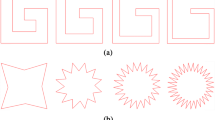Abstract
It has been known for some time that distorted finite elements produce relatively (and, sometimes, dramatically) poor results. This has been related to the completeness condition. In this paper, we investigate this issue and propose that the abstract mathematical viewpoint represented by the completeness condition is actually a statement of the physical need for a finite element computation to recover accurate stresses in the metric space. This follows from the projection theorem describing finite element analysis which shows that the stresses computed by the displacement finite element procedure are abest approximation of the true stresses at an element as well as global level. The simplest possible element is used to elucidate the principles.
Similar content being viewed by others
References
Arnold D N, Babuška I, Osborn J 1984 Finite element methods: Principles for their selection.Comput. Meth. Appl. Mech. Eng. 45: 57–96
Arnold D N, Boffi D, Falk R S 2002 Approximation by quadrilateral finite elements.Math. Comput. 71:909–922
Babuska I, Stroubolis T 2001The finite element method and its reliability (Oxford: Clarendon)
Backlund J 1978 On isoparametric elements.Int. J. Numer. Meth. Eng. 12: 731–732
Bathe K J, Iosilevich A, Chapelle D 2000 An inf-sup condition for shell finite elements.Comput. Struct. 75: 439–456
Gifford L N 1979 More on distorted isoparametric elements.Int. J. Numer. Meth. Eng. 14: 290–291
Iosilevich A, Bathe K J, Brezzi F 1997 On evaluating the inf-sup condition for plate bending elements.Int. J. Numer. Meth. Eng. 40: 3639–3663
Ooi E T, Rajendran S, Yeo J H 2004 A 20-node hexahedron element with enhanced distortion tolerance.Int. J. Numer. Meth. Eng. 60: 2501–2530
Prathap G 1993The finite element method in structural mechanics (Dordrecht: Kluwer Academic)
Prathap G, Mukherjee S 2003 The engineer grapples with theorem 1.1 and lemma 6.3 of Strang and Fix.Curr. Sci. 85: 989–994
Prathap G, Mukherjee S 2004 Management-by-stress model of finite element computation. Research Report CM 0405, CSIR Centre for Mathematical Modelling and Computer Simulation, Bangalore, November
Prathap G, Manju S, Senthilkumar V 2005 The unsymmetric formulation and variational correctness. Research Report CM 0506, CSIR Centre for Mathematical Modelling and Computer Simulation, Bangalore, June
Rajendran S, Liew K M 2003 A novel unsymmetric 8-node plane element immune to mesh distortion under a quadratic field.Int. J. Numer. Meth. Eng. 58: 1718–1748
Rajendran S, Subramanian S 2004 Mesh distortion sensitivity of 8-node plane elasticity elements based on parametric, metric, parametric-metric, and metric-parametric formulations.Struct. Eng. Mech. 17: 767–788
Strang G, Fix G J 1973An analysis of the finite element method (Englewood Cliffs, NJ: Prentice-Hall)
Stricklin J A, Ho W S, Richardson E Q, Haisler W E 1977 On isoparametric vs. linear strain triangular elements.Int. J. Numer. Methods Eng. 11: 1041–1043
Author information
Authors and Affiliations
Rights and permissions
About this article
Cite this article
Prathap, G., Senthilkumar, V. & Manju, S. Mesh distortion immunity of finite elements and the best-fit paradigm. Sadhana 31, 505–514 (2006). https://doi.org/10.1007/BF02715909
Received:
Revised:
Issue Date:
DOI: https://doi.org/10.1007/BF02715909




